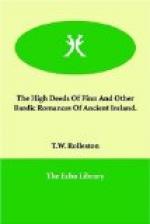The third cycle is called Fenian because its legends tell, for the most part, of the great deeds of the Feni or Fianna, who were the militia employed by the High King to support his supremacy, to keep Ireland in order, to defend the country from foreign invasion. They were, it seems, finally organized by Cormac mac Art, 227 A.D.(?) the grandson of Conn the Hundred Fighter. But they had loosely existed before in the time of Conn and his son Art, and like all mercenary bodies of this kind were sometimes at war with the kings who employed them. Finally, at the battle of Gowra, they and their power were quite destroyed. Long before this destruction, they were led in the reign of Cormac by Finn the son of Cumhal, and it is around Finn and Oisin the son of Finn, that most of the romances of the Fenian cycle are gathered. Others which tell of the battles and deeds of Conn and Art and Cormac and Cairbre of the Liffey, Cormac’s son, are more or less linked on to the Fenians. On the whole, Finn and his warriors, each of a distinct character, warlike skill and renown, are the main personages of the cycle, and though Finn is not the greatest warrior, he is their head and master because he is the wisest; and this masterdom by knowledge is for the first time an element in Irish stories.
If the tales of the first cycle are mythological and of the second heroic, these are romantic. The gods have lost their dreadful, even their savage character, and have become the Fairies, full often of gentleness, grace, and humour. The mysterious dwelling places of the gods in the sea, in unknown lands, in the wandering air, are now in palaces under the green hills of Ireland, or by the banks of swift clear rivers, like the palace of Angus near the Boyne, or across the seas in Tir-na-n-Og, the land of immortal youth, whither Niam brings Oisin to live with her in love, as Morgan le Fay brought Ogier the Dane to her fairyland. The land of the Immortals in the heroic cycle, to which, in the story of Etain and Midir in this book, Midir brings back Etain after she has sojourned for a time on earth, is quite different in conception from the Land of Youth over the far seas where delightfulness of life and love is perfect. This, in its conception of an unknown world where is immortal youth, where stormless skies, happy hunting, strange adventure, gentle manners dwell, where love is free and time is unmarked, is pure romance. So are the adventures of Finn against enchanters, as in the story of the Birth of Oisin, of Dermot in the Country under the Seas, in the story of the Pursuit of the Gilla Dacar, of the wild love-tale of Dermot and Grania, flying for many years over all Ireland from the wrath of Finn, and of a host of other tales of enchantments and battle, and love, and hunting, and feasts, and discoveries, and journeys, invasions, courtships, and solemn mournings. No doubt the romantic atmosphere has been deepened in these tales by additions made to them by successive generations of bardic singers and storytellers, but for all that the original elements in the stories are romantic as they are not in the previous cycles.




